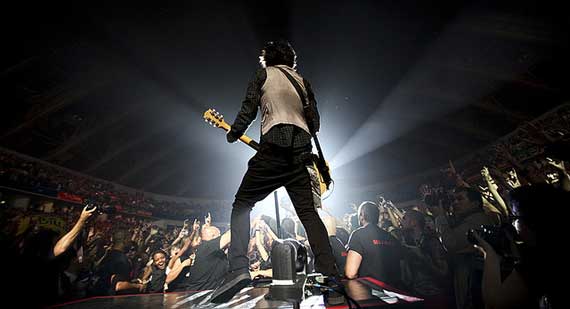Is Green Day Still Punk?

While critics are unanimous in labeling Green Day’s early material as punk music, the band’s multitude of stylistic ventures throughout their 25–year career makes it difficult to label them today. Are they still a staunch punk-rock band, as they were in their youth, or a fusion of varying rock and pop genres? Fans of more traditional punk staples – like the Dead Kennedys, Black Flag, and The Clash – will likely argue that Green Day today are more pop-punk, in the vein of emo-rock like Fall Out Boy and Brand New. The other side would take fault with comparing Green Day to bands they influenced directly.
It can be argued that 1997’s Nimrod was Green Day’s last legitimate punk release. Fast-paced punk returned to their arsenal after 1995’s Insomniac presented chirpy punk-pop for the most part, with only glimpses of their vintage punk sound. With its experimental nature, Nimrod felt like a more appropriate follow-up to the band’s classic Dookie. Opening track “Nice Guys Finish Last” kick-started the back-to-punk formula, with a deeply reverberating bass line reflecting its three notes over reflectively distorted guitar chords. Nimrod wasn’t a strictly punk release, especially with a pulsating effort like “Hitchin’ a Ride” reminding of anthemic Brit-rockers like Manic Street Preachers, another group that treaded the spectrum between punk-rock and alternative and found several highs and lows as a result. But the 18 tracks on Nimrod whizzed by in a flash, propelling its sporadic bursts of old-school punk sound into something exciting despite its recent hybridization. Some more editing would have improved the album’s daunting flow, but then again – shoddy editing is certainly a characteristic of some punk-rock as well. It contributed to the appeal for most fans.
Green Day kicked off their definitive punk-pop phase with 2000’s Warning, one of their most accessible efforts with its mix of straight-cut rockers and intense guitar-led punk-rock. The latter half of Warning is particularly indicative of the band’s recent exploration. The album’s gorgeous closer and its only ballad, “Macy’s Day Parade”, plays with three chords during its jangly verses, teasing listeners with a devastating chorus that doesn’t arrive until the second go-around. Others in the latter half show similar ambition. Acoustics and harmonica clash for the raucously enjoyable “Hold On”, while the anthemic push of “Deadbeat Holiday” rides on predictable good-natured fun. Remnants of their original punk sound are apparent to some extent on “Blood, Sex, and Booze” and “Fashion Victim”, but these are very specific moments, like the former’s crunchy chorus. It was apparent to most fans after the first listen that Warning was a quality release, but not necessarily one that abided by Green Day’s anticipated fast punk delivery.
The 2000s marked a period where Green Day were becoming more mature with their songwriting, relying more on arrangements and melodic theatrics than flat-out intensity. Politics also became a more prominent theme within their lyrics. In Green Day’s case, more maturity meant less swift-paced punk. Key tracks on the wildly popular American Idiot were demonstrative of this. The reputable “Wake Me Up When September Ends” has a political undercurrent, like many punk songs, but its musical accompaniments of teary-eyed acoustics align more with alternative-rock and emo. Especially as a concept album, American Idiot achieved massive worldwide success. Tracks like “Boulevard of Broken Dreams” and the aforementioned “Wake Me Up” saw Green Day play radio stations fans would have never predicted a decade earlier. Green Day were still making quality songs, but their sound had become safer and more restrained, with a knack for radio-friendly power-pop and punk-pop rather than the ferocious punk that had helped them emerge in the ‘90s with Dookie.
Green Day’s latest decision to release a trilogy of albums, starting with ¡Uno! and concluding with ¡Tré!, coincides with the ambition they have been pursuing the past decade – with a plethora of styles infused into their punk-pop output. Arena-rockers like “Oh Love” and “Angel Blue” are similar to the punk-pop on Warning and American Idiot, though an effort like “Kill the DJ” takes a swift art-rock approach that resembles the likes of Arctic Monkeys, with a tinge of dance-rock. Green Day are not the type to write songs that are ripe for remixing, but that one might actually work. Meanwhile, “Sweet 16” resembles the chirpy West Coast indie-pop of Phantom Planet and Rooney. Who would have thought Green Day would ever put out something like that? Classifying Green Day stylistically has to be done on a track-by-track basis at this point. Asking whether or not Green Day still produce punk is entirely dependent on which song, or era, you’re referring to.
